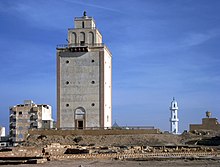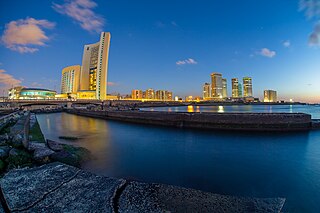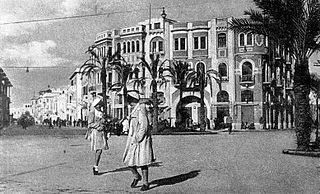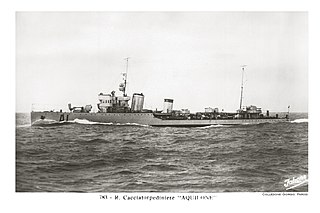
The Benghazi Lighthouse is an active lighthouse located on the coast of Libya in the neighborhood of the Sidi Khrebish area in Benghazi. [1] Its NGA number is 21508.

The Benghazi Lighthouse is an active lighthouse located on the coast of Libya in the neighborhood of the Sidi Khrebish area in Benghazi. [1] Its NGA number is 21508.
Built in 1922 during the Italian colonization of Libya and inaugurated in 1928, it is one of Benghazi's oldest and most prominent historical landmarks. As well as guiding ships, it was also used as a water tower.
The lighthouse is 22 m (72 ft) high and has a focal height of 41 m (135 ft). The light has a range of 17 nautical miles. [1]

The lighthouse sustained some damage during World War II, but was much more severely damaged in the recent Libyan civil war. Some of the Islamist opponents of the military commander Khalifa Hafter took shelter in the lighthouse, and later used it to bury about 200 of their dead. Airstrikes hit the upper chamber and took out the lantern which fell but was not destroyed.
In 2014, a 5-meter diameter clock in the colors of the national flag was inserted into the sea-facing side of the lighthouse, a donation from businessman Abubakr Sheikh, [2] in spite of opposition from the architectural community. [3]
A renovation project announced in 2019 aims restore the lighthouse to its original state, and is projected to take 13 to 17 months. The project was initiated and funded by Benghazi's local authority, which is part of Libya's eastern interim government, headed by Abdullah al-Thinni. [4]

Tripoli is the capital and largest city of Libya, with a population of about 1.18 million people in 2019. It is located in the northwest of Libya on the edge of the desert, on a point of rocky land projecting into the Mediterranean Sea and forming a bay. It includes the port of Tripoli and the country's largest commercial and manufacturing center. It is also the site of the University of Tripoli. The vast Bab al-Azizia barracks, which includes the former family estate of Muammar Gaddafi, is also located in the city. Colonel Gaddafi largely ruled the country from his residence in this barracks.

Benghazi is the second-most populous city in Libya as well as the largest city in Cyrenaica, with an estimated population of 1,207,250 in 2020. Located on the Gulf of Sidra in the Mediterranean, Benghazi is also a major seaport.

The Great Man-Made River is a network of pipes that supplies fresh water obtained from the Nubian Sandstone Aquifer System fossil aquifer across Libya. It is the world's largest irrigation project. The project utilizes a pipeline system that pumps water from the Nubian Sandstone Aquifer System from down south in Libya to cities in the populous Libyan northern Mediterranean coast including Tripoli and Benghazi. The water covers a distance of up to 1,600 kilometers and provides 70% of all freshwater used in Libya.

The Libyan Navy is the naval warfare branch of the Libyan Armed Forces. Established in November 1962, Libyan Navy has been headed by Admiral Mansour Bader, Chief of Staff of the Libyan Naval Force. Before the First Libyan Civil War it was a fairly typical small navy with a few missile frigates, corvettes and patrol boats to defend the coastline, but with a very limited self-defence capability.

The history of the Jews in Libya stretches back to the 3rd century BCE, when Cyrenaica was under Greek rule. The Jewish population of Libya, a part of the Sephardi-Maghrebi Jewish community continued to populate the area continuously until the modern times. During World War II, Libya's Jewish population was subjected to antisemitic laws by the Fascist Italian regime and deportations by Nazi German troops.

The Italian colonizationof Libya began in 1911 and it lasted until 1943. The country, which was previously an Ottoman possession, was occupied by Italy in 1911 after the Italo-Turkish War, which resulted in the establishment of two colonies: Italian Tripolitania and Italian Cyrenaica. In 1934, the two colonies were merged into one colony which was named the colony of Italian Libya. In 1937, this colony was divided into four provinces, and in 1939, the coastal provinces became a part of metropolitan Italy. The colonization lasted until Libya's occupation by Allied forces in 1943, but it was not until the 1947 Paris Peace Treaty that Italy officially renounced all of its claims to Libya's territory.

The Koni class is the NATO reporting name for an anti-submarine warfare frigate built by the Soviet Union. They were known in the Soviet Union as Project 1159. 14 were built in Zelenodolsk shipyard between 1975 and 1988. They were originally intended to replace the older Riga-class frigates, but were instead chosen as a design for export to various friendly navies. The Koni I sub class were designed for European waters and the Koni II were made for warmer waters. One ship was retained by the Soviets in the Black Sea for training foreign crews. Only a few of these vessels remain in service today.
There have been no operational railways in Libya since 1965, but various lines existed in the past. Since 1998, plans for an extensive system have been developed, but work has largely halted since the outbreak of the First Libyan Civil War in 2011.
A health care crisis currently exists in Libya due to the ongoing conflict.

Italian Libyans are Libyan-born citizens who are fully or partially of Italian descent, whose ancestors were Italians who emigrated to Libya during the Italian diaspora, or Italian-born people in Libya. Most of the Italians moved to Libya during the Italian colonial period.

The Port of Tripoli is the principal seaport in Tripoli, the capital of Libya, and one of the oldest ports in the Mediterranean. The port serves general cargo, bulk cargo & passengers.

Benghazi Cathedral is a former Roman Catholic church in the city of Benghazi, Libya. It is located in the city center.
The Port of Benghazi is a major seaport in the city of Benghazi, Libya, on the Mediterranean Sea coast within the Gulf of Sidra.

The First Battle of Benghazi occurred as part of the Libyan Civil War between army units and militiamen loyal to Libyan leader Muammar Gaddafi and anti-Gaddafi forces in February 2011. The battle mainly took place in Benghazi, the second-largest city in Libya, with related clashes occurring in the nearby Cyrenaican cities of Bayda and Derna. In Benghazi itself most of the fighting occurred during a siege of the government-controlled Katiba compound.

The Second Battle of Benghazi was a battle in the Libyan Civil War between army units and militiamen loyal to Libyan leader Muammar Gaddafi, and anti-Gaddafi forces in Benghazi. The battle marked the start of a United Nations-mandated military intervention in the conflict, with fighter jets from the French Air Force attacking and destroying several pro-Gaddafi units, forcing them to retreat.

HMS Regent was a Rainbow-class submarine designed and built by Vickers Shipbuilding and Engineering in Barrow-in-Furness for the Royal Navy, and was launched on 11 June 1930. She was lost with all hands after striking a mine on 18 April 1943.

The 2012 Benghazi attack was a coordinated attack against two United States government facilities in Benghazi, Libya, by members of the Islamic militant group Ansar al-Sharia.

Italian Benghazi was the name used during the Italian colonization of Libya for the port-city of Benghazi in Italian Cyrenaica.

The Galeb class, also known as the Orao class, were minelayers originally built as minesweepers for the Imperial German Navy between 1918 and 1919.

Aquilone was one of eight Turbine-class destroyers built for the Regia Marina during the late 1920s. She was named after Aquilone, a cold northerly wind.